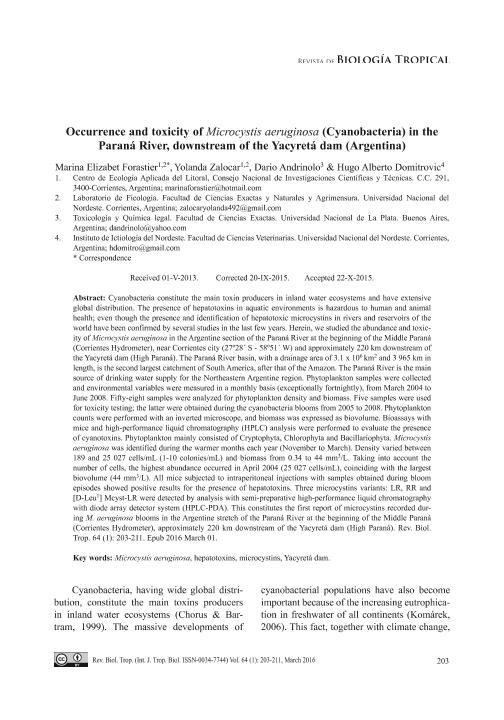Artículo
Occurrence and toxicity of Microcystis aeruginosa (Cyanobacteria) in the Paraná River, downstream of the Yacyretá dam (Argentina)
Fecha de publicación:
03/2016
Editorial:
Universidad de Costa Rica
Revista:
Revista de Biología Tropical
ISSN:
0034-7744
e-ISSN:
2215-2075
Idioma:
Inglés
Tipo de recurso:
Artículo publicado
Clasificación temática:
Resumen
Cyanobacteria constitute the main toxin producers in inland water ecosystems and have extensive global distribution. The presence of hepatotoxins in aquatic environments is hazardous to human and animal health; even though the presence and identification of hepatotoxic microcystins in rivers and reservoirs of the world have been confirmed by several studies in the last few years. Herein, we studied the abundance and toxicity of Microcystis aeruginosa in the Argentine section of the Paraná River at the beginning of the Middle Paraná (Corrientes Hydrometer), near Corrientes city (27º28´ S - 58º51´ W) and approximately 220 km downstream of the Yacyretá dam (High Paraná). The Paraná River basin, with a drainage area of 3.1 x 106 km2 and 3 965 km in length, is the second largest catchment of South America, after that of the Amazon. The Paraná River is the main source of drinking water supply for the Northeastern Argentine region. Phytoplankton samples were collected and environmental variables were measured in a monthly basis (exceptionally fortnightly), from March 2004 to June 2008. Fifty-eight samples were analyzed for phytoplankton density and biomass. Five samples were used for toxicity testing; the latter were obtained during the cyanobacteria blooms from 2005 to 2008. Phytoplankton counts were performed with an inverted microscope, and biomass was expressed as biovolume. Bioassays with mice and high-performance liquid chromatography (HPLC) analysis were performed to evaluate the presence of cyanotoxins. Phytoplankton mainly consisted of Cryptophyta, Chlorophyta and Bacillariophyta. Microcystis aeruginosa was identified during the warmer months each year (November to March). Density varied between 189 and 25 027 cells/mL (1-10 colonies/mL) and biomass from 0.34 to 44 mm3/L. Taking into account the number of cells, the highest abundance occurred in April 2004 (25 027 cells/mL), coinciding with the largest biovolume (44 mm3/L). All mice subjected to intraperitoneal injections with samples obtained during bloom episodes showed positive results for the presence of hepatotoxins. Three microcystins variants: LR, RR and [D-Leu1] Mcyst-LR were detected by analysis with semi-preparative high-performance liquid chromatography with diode array detector system (HPLC-PDA). This constitutes the first report of microcystins recorded during M. aeruginosa blooms in the Argentine stretch of the Paraná River at the beginning of the Middle Paraná (Corrientes Hydrometer), approximately 220 km downstream of the Yacyretá dam (High Paraná).
Palabras clave:
Microcystis Aeruginosa
,
Hepatotoxins
,
Microcystins
,
Yacyretá Dam
Archivos asociados
Licencia
Identificadores
Colecciones
Articulos(CCT - LA PLATA)
Articulos de CTRO.CIENTIFICO TECNOL.CONICET - LA PLATA
Articulos de CTRO.CIENTIFICO TECNOL.CONICET - LA PLATA
Articulos(CECOAL)
Articulos de CENTRO DE ECOLOGIA APLICADA DEL LITORAL (I)
Articulos de CENTRO DE ECOLOGIA APLICADA DEL LITORAL (I)
Citación
Forastier, Marina; Zalocar, Yolanda; Andrinolo, Dario; Domitrovic, Hugo Alberto; Occurrence and toxicity of Microcystis aeruginosa (Cyanobacteria) in the Paraná River, downstream of the Yacyretá dam (Argentina); Universidad de Costa Rica; Revista de Biología Tropical; 64; 1; 3-2016; 203-211
Compartir
Altmétricas




